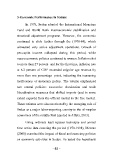Page 533 - 2016 - Vol. 40
P. 533
3-Economic Performance in Sudan:
In 1978, Sudan adopted the International Monetary
Fund and World Bank macroeconomic stabilization and
structural adjustment programs. However, the economic
continued to slide further through the (1978-84), which
witnessed very active adjustment operations. Growth of
per-capita income collapsed during this period, while
macroeconomic policies continued to worsen. Inflation shot
to more than 27 percent and for the first time, inflation rate
at 6.2 percent of GDP exceeded seignior age revenue by
more than one percentage point, indicating the increasing
inefficiency of monetary policy. The reform emphasized
two central policies: successive devaluation and trade
liberalization measures that shifted imports (and to some
extent exports) from the official market to the free market.
These reforms were also motivated by the emerging role of
Sudan as a major labor-exporting country to the oil-surplus
economies of the middle-East (quoted in Alfaki, 2013).
Using ordinary least squares technique and annual
time series data covering the period (1970-1998), Meezan
(2000) examined the impact of fiscal and monetary policies
on economic activities in Sudan. He tested the hypothesis
- 45 -

